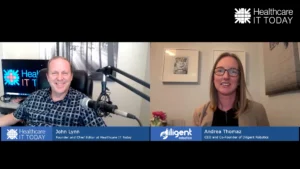The following is a guest article by Nate MacLeitch, Founder and CEO at QuickBlox
An analysis of 23,000 malpractice lawsuits revealed more than 7,000 of them stemmed from communication breakdowns. That’s $1.7B in costs that might have been avoided with clearer, more consistent messaging between providers and patients.
At the same time, 92% of patients say they expect personalized reminders and messages from their providers. So, why is it still so hard to get communication right in healthcare settings?
The Trusted Exchange Framework and Common Agreement (TEFCA) promises to improve interoperability by standardizing data sharing between health information networks across the U.S. This will result in fewer information silos, better care transitions, and more consistent patient records.
However, communication errors go beyond access to records. Even when the data is there, missed lab results, unclear discharge plans, and failures to follow up can happen. Healthcare providers who leverage automated communication support in their daily workflows can ensure they access the right information and act on it at the right time.
TEFCA links systems, and AI-powered automation allows the data to speak. We are seeing tools where clinicians can receive real-time alerts, click into applications, and ask the data questions. Let’s take a closer look.
What is TEFCA?
In 2023, 60% of health systems received duplicated, incomplete, and junk data. TEFCA understands that U.S. patients’ medical data needs to be shared effectively and carefully secured.
By creating a common set of rules and protocols and defining how Qualified Health Information Networks (QHINs) interact, affiliated systems can exchange data securely and reliably. In February earlier this year, the U.S. Department of Health and Human Services announced the first six organizations approved as QHINs under TEFCA.
Patients often receive care from multiple providers. For instance, the ER needs access to data from the patient’s family practitioner. TEFCA helps ensure that critical health information follows the patient, without interoperability issues such as format errors, duplication, delays, and consequently, safety risks.
In its first year, TEFCA facilitated the exchange of 7.8 million documents, and other interoperability initiatives like Carequality, which covers 50,000 outpatient clinics and 4,200 hospitals, plan to align with TEFCA by the end of 2025.
Why Communication Breakdowns Persist Despite Interoperability
Communication failures in healthcare are rarely the result of individual neglect. They’re rooted in the structure and pressures of modern clinical environments. While TEFCA has improved data access, the realities of fragmented workflows, time-sensitive decisions, and nuanced hierarchies still shape who gets what information, and when.
Data from New York State reveals discharge delays resulted in a collective loss of $169 million for 52 hospitals in just three months. When medically stable patients remain hospitalized due to issues such as incomplete discharge paperwork or a breakdown in communication with the receiving facility, this prevents a bed from being turned.
Or take misrouted referrals, test results that go unreviewed for days, and patients who assume “no news is good news” because no one followed up. These are regular features of a system stretched thin by inefficiency and volume. A systematic review reported that the latter occurred in 6.8% to 62% of laboratory tests and 1.0% to 35.7% of radiology tests.
Technology moves data, but it doesn’t redesign decision-making. It doesn’t create accountability. And it doesn’t bridge the gaps created by conflicting priorities and unpredictable circumstances. It is a tool to help streamline workflows and alleviate pressure on healthcare professionals so they can gain time back to meet their responsibilities and support with unforeseen events.
How Technology Can Improve Patient Workflows
Patients want to know what is going on with them right away, whether it’s good or bad. The wait just adds to anxiety: A 2023 survey of over 8,000 respondents found that 96% would prefer receiving results through patient portals as soon as they are available, even if their provider has not yet reviewed them.
Patient confidence in automated messaging and copilots is also growing: two-thirds of insured Americans say they would trust a health insurer’s artificial intelligence copilot to inform them about a health plan’s benefits accurately.
Automating follow-ups with AI conversational chatbots not only ensures patients receive necessary updates, but it can also help simplify the language to suit the patient. It’s easy to forget that medical words such as “hypertension” and “CBC” can be confusing when staff use them all day, every day. AI medical assistants can be trained to ensure that diagnosis and treatment information is delivered in the language and tone suited to the patient.
Its usefulness extends to doctors as well. Already, Stanford Health Care clinicians are chatting with patient medical records through AI-backed software called ChatEHR. “What medications is the patient currently taking? Are there any abnormal lab values that need follow-up?” Clinicians can ask for a summary of patients’ charts or retrieve specific data points relevant to the patient’s care.
Over at The Christ Hospital, we are seeing a similar story. Clinicians are using AI medical assistants to identify and manage lung cancer by extracting findings and follow-ups from radiologists’ reports. Since August, it has helped clinicians detect cancer earlier and initiate over 50 cancer treatments.
The global clinical communication and collaboration market size, calculated at $2.54 billion in 2025, is anticipated to expand at a CAGR of 11.64% from 2025 to 2034. North America dominated the market, driven by certain factors such as increased healthcare expenditure, increased demand for automated technology, a rising number of patients, a growing geriatric population, and an increasing need for effective communication across hospitals and clinics.
AI chatbot assistants, AI triage for inbound messages, and treatment plans that are simplified and translated to suit the patient can help the healthcare industry overcome many of the major barriers to effective communication. Whether it is a doctor asking for an update on the patient’s medical history or a patient requesting care plan explanations, these tools are digesting data and recalling information based on the user’s prompt.
TEFCA lays the groundwork for broader interoperability in US healthcare, but data availability alone doesn’t improve care. Clinical teams need systems that translate shared data into clear, actionable information—delivered to the right person, at the right moment, in the right context. Without that, critical communication gaps will persist.
 About Nate MacLeitch
About Nate MacLeitch
Nate MacLeitch is a highly experienced business professional with a diverse background in industries such as telecom, media, software, and technology. He began his career as a Trade Representative for the State of California in London and has since held key leadership positions, including Head of Sales at WIN Plc (now Cisco) and COO at Twistbox Entertainment (now Digital Turbine). Currently, he serves as the CEO at QuickBlox, a leading AI communication platform. Beyond his work experience, Nate is actively involved as an advisor and investor in startups like whisk.com, Firstday Healthcare, and TechStars. He holds degrees from UC Davis and The London School of Economics and Political Science (LSE).



